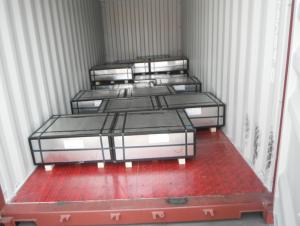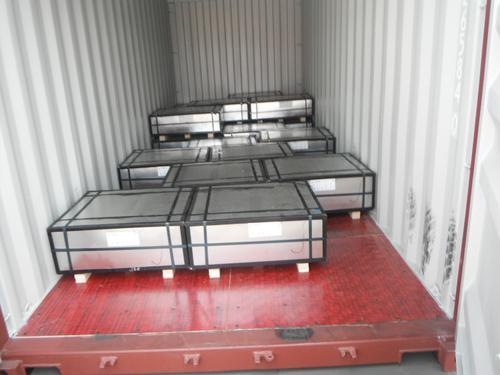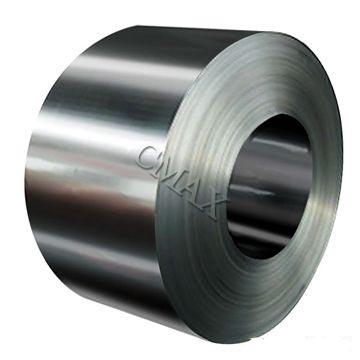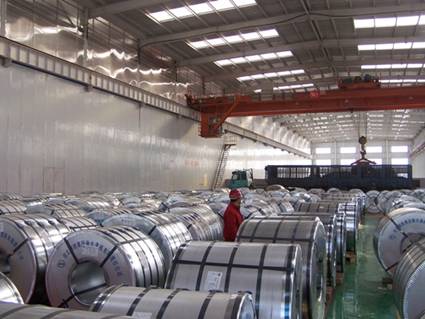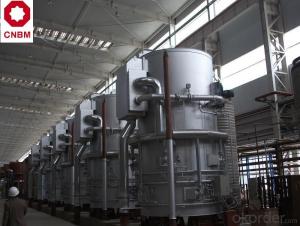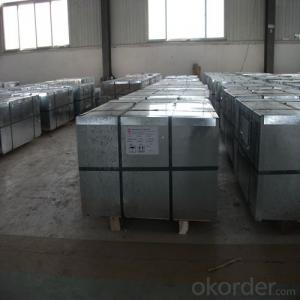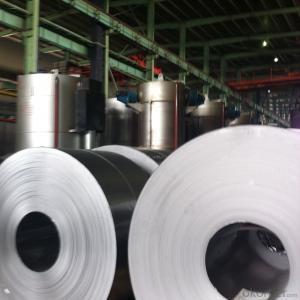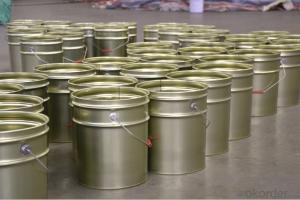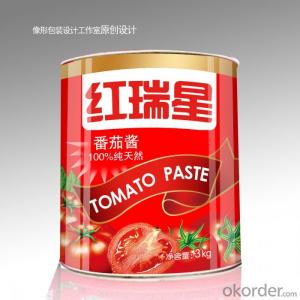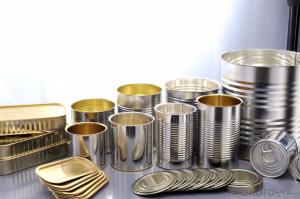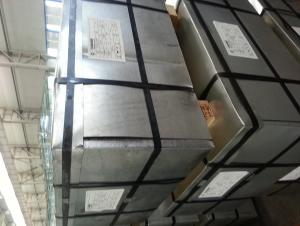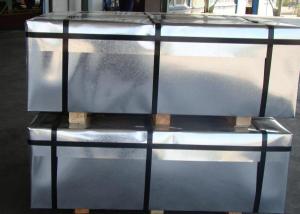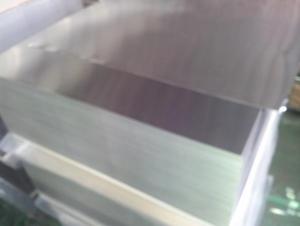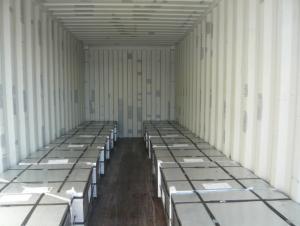Tinplate Coil, SPCC Material, Stone Finish, JIS G 3303 For Paint Cans
- Loading Port:
- Tianjin
- Payment Terms:
- TT OR LC
- Min Order Qty:
- 25 m.t.
- Supply Capability:
- 10000 m.t./month
OKorder Service Pledge
OKorder Financial Service
You Might Also Like
1.Brief Introduction
Tinplate is widely used for making all types of containers, containing industrial usage such as paint can, oil can, aerosol cans etc., and food cans like milk powder cans, tomato paste can, dry food cans etc.
2. Quality
As a state owned company and a large tinplate supplier in China, our tinplate quality ranks 1st level in China, similar to Bao Steel, Posco etc.
3. Specification
standard: GB/T2520, JIS G3303, DIN EN10202
Material: MR /SPCC
Thickness available: 0.16-0.50MM
Width available: 600~1050MM
Temper grade: T1 – DR8
Tin coating: ordinary 2.8g/2.8g, 5.6g/5.6g and others
Package: sea worthy export package.
Applications: Tin can for chemicals & paint cans, industrial cans, food cans
4. Our production steps
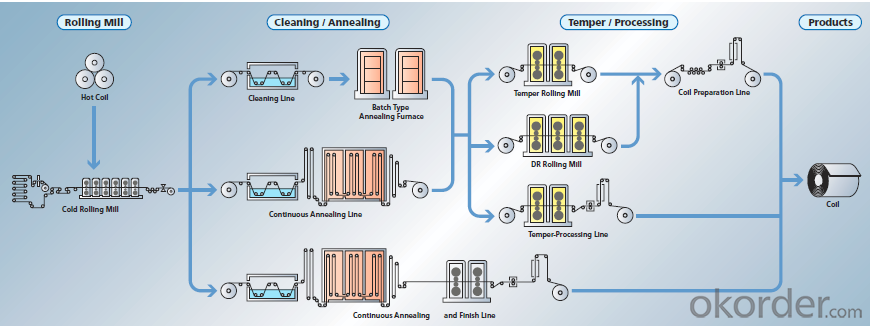
5. Usage Scope
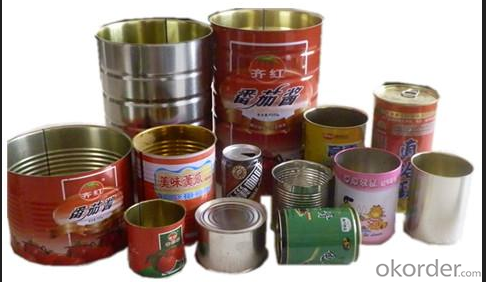
6. Our euxport market
our tinplate has been popularly exported to more than 30 countries, including Asia, Europe countries, Gulf area, Sounth America, Northe & South Afric etc.
7. FAQ
a. what's the annual output?
about 500,000 tons per year.
b. where's the raw matrial from?
our hot rolled coil is purchased from Capital Steel and other state owned mill, with quite good quality.
c. how long is the delivery time?
normally for SPCC about 45~55 days, while 65~75 days for MR material
d. how to control the quality during production process?
inside our workshop, we have MES syestem. It realizes the optimization of the production procedure in the workshop. It could record each step of the whole production procedures, and if some problem appears, factory could easily found and take action, it’s quite helpful to monitor and control the quality.
- Q: How does tinplate perform in terms of heat resistance?
- Tinplate has a relatively low heat resistance compared to other metal materials. It can withstand moderate temperatures without significant deformation or damage, but it is not suitable for high-temperature applications.
- Q: What are the main applications of tinplate in the pharmaceutical industry?
- Tinplate is commonly used in the pharmaceutical industry for packaging purposes. It serves as a reliable and durable material for manufacturing cans, containers, or closures for various pharmaceutical products. Tinplate provides an effective barrier against moisture, light, and oxygen, helping to preserve the integrity, stability, and shelf life of pharmaceutical drugs. Additionally, tinplate's resistance to corrosion ensures the safety and quality of the packaged medications.
- Q: What are the advantages of using tinplate?
- Some of the advantages of using tinplate include its high strength and durability, excellent corrosion resistance, and its ability to be easily formed and shaped. Tinplate also provides a barrier against oxygen, moisture, and light, making it ideal for packaging food and beverages. Additionally, tinplate is recyclable, making it a sustainable choice for packaging materials.
- Q: What are the main applications of tinplate in the aerospace industry?
- Tinplate is commonly used in the aerospace industry for various applications such as manufacturing fuel tanks, hydraulic systems, and electrical components. It provides excellent corrosion resistance, durability, and conductivity, making it ideal for these critical applications. Additionally, tinplate is lightweight, which is essential in aerospace to reduce overall weight and enhance fuel efficiency.
- Q: How does tinplate contribute to the performance of sports equipment?
- Tinplate contributes to the performance of sports equipment by providing a lightweight, durable, and corrosion-resistant material for manufacturing various components. It is commonly used in the production of tennis racket frames, baseball bat barrels, and golf club heads, among others. The strength and flexibility of tinplate enhance the overall performance of the equipment, allowing athletes to achieve better control, accuracy, and power in their respective sports. Additionally, the protective coating of tin on the surface helps prevent rusting and extends the lifespan of the equipment, ensuring consistent performance over time.
- Q: Can tinplate be used for promotional items?
- Yes, tinplate can definitely be used for promotional items. Its versatility, durability, and customizable design options make it a popular choice for creating unique and eye-catching promotional products such as tin boxes, tin signs, tin coasters, and more. Tinplate's ability to be printed with high-quality graphics and logos also allows businesses to effectively showcase their brand and attract attention to their promotional campaigns.
- Q: What are the advantages of using tinplate for toys and games?
- One advantage of using tinplate for toys and games is its durability. Tinplate is a strong material that can withstand rough play and handling, making it ideal for toys that may be subjected to frequent use and potential impacts. Additionally, tinplate is resistant to corrosion, ensuring that the toys and games made from this material will last longer and maintain their quality. Furthermore, tinplate can be easily shaped and molded into various designs, allowing for the creation of intricate and detailed toys and games. Overall, the use of tinplate in the manufacturing of toys and games offers advantages in terms of durability, longevity, and design flexibility.
- Q: What are the main challenges in recycling tinplate?
- The main challenges in recycling tinplate include the separation of tin from the steel base, the removal of any contaminants or coatings on the tinplate, and ensuring the proper sorting and collection of tinplate waste to prevent it from ending up in landfills. Additionally, the energy-intensive process of melting and refining tinplate poses environmental concerns and requires adequate infrastructure for recycling facilities.
- Q: Can tinplate be used for non-packaging applications?
- Yes, tinplate can be used for non-packaging applications. Tinplate's excellent corrosion resistance, ductility, and formability make it suitable for various non-packaging uses such as automotive parts, construction materials, electrical components, and decorative purposes.
- Q: What are the differences in the corrosion behavior of two ferrous iron products?
- Tinplate is a tin covered with tin, it is not easy to rust, also known as tin iron. This kind of galvanized steel in a long time Chinese called "tin", some people think that the tin plate cans was made from the Guangdong province of Macao (English Macao readable if imported, tin) so called "tin".
Send your message to us
Tinplate Coil, SPCC Material, Stone Finish, JIS G 3303 For Paint Cans
- Loading Port:
- Tianjin
- Payment Terms:
- TT OR LC
- Min Order Qty:
- 25 m.t.
- Supply Capability:
- 10000 m.t./month
OKorder Service Pledge
OKorder Financial Service
Similar products
Hot products
Hot Searches
Related keywords
